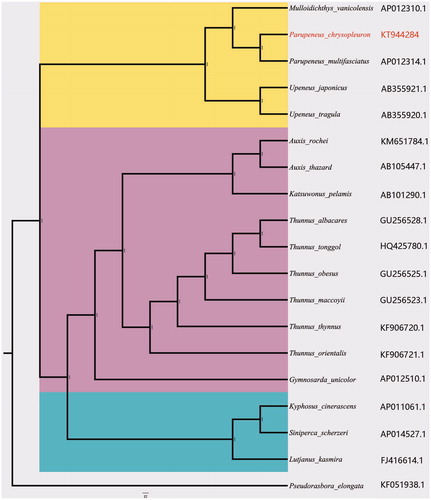Abstract
Parupeneus chrysopleuron were under threat of climate change and unregulated fishing. For protecting the fish, complete mitochondrial genome (mitogenome) of P. chrysopleuron was firstly determined. The mitogenome is 17,397 nucleotides, including 38 genes. The gene arrangement of the P. chrysopleuron mitogenome is different from most of bony fishes. Investigating the mitochondrial gene arrangement pattern found that the tRNAIle and tRNAGln, followed by tRNAMe. Observing four notable non-coding regions, a non-coding region of 814 bp was identified as control region based on its location and central conserved sequence blocks (CSB-1 and CSB-2) were recognized.
Parupeneus chrysopleuron was first described by Temminck & Schlegel in 1843, which belongs to the Mullidae. It is a demersal fish and distributes in tropical waters of Indo-West Pacific. So far the climate change, rises in sea temperature, ocean acidification and overfishing are major threat to the P. chrysopleuron. It is very important to characterize the mitogenome of P. chrysopleuron, which can be utilized in research on taxonomic resolution, population genetic structure and phylogenetic relationships. We sequenced the complete nucleotide sequence for the mitogenome of P. chrysopleuron. The samples were collected from the East China Sea (25.6°N, 123.5°E) and was kept at the Museum of Marine Biology at Zhejiang Ocean University (Index number: MMB-2014-0201).
The mitogenome of P. chrysopleuron is a closed double-stranded circular molecule of 17397 nucleotides (GenBank accession number: KT944284) and contains 13 protein-coding genes, 2 ribosomal RNA genes, 23 tRNA genes and 4 non-coding regions. The overall base composition was T 25.1%, C 30.1%, A 26.0%, and G 18.8%, with a slight A + T bias of 51.1%. The A + T (51.1%) content is higher than G + C (48.9%) content, which is similar to the other fishes (Jin et al. Citation2013). Furthermore, the anti-G bias is ascertained in the third position of protein-coding genes, which brings P. chrysopleuron in line with other vertebrate mitogenomes (Cheng et al. Citation2011, Citation2012; Xu et al. Citation2011). Nine mitochondrial genes (ND6, tRNA-Gln, Ala, Asn, Cys, Tyr, Ser, Glu and Pro) are transcribed from light strand and the remaining encoded on the heavy strand. Four non-coding regions exist with 119, 814, 337 and 331 nucleotides, respectively.
Few reports on the surprising rearrangement of mitogenome, while the gene arrangement of P. chrysopleuron mitogenome is different from other Mullidae species that generally contain 13 protein-coding genes, 2 ribosomal RNAs, 22 transfer RNAs and 1 putative control region. For most Mullidae mitogenomes, tRNAIle, tRNAGln, and tRNAMet are orderly placed between ND1 and ND2, but in P. chrysopleuron mitogenome, tRNAIle and tRNAGln were maped after tRNAPro, followed by another tRNAMet. And the mitogenome of P. chrysopleuron contains 23 tRNA because of the replication of tRNAMet. The 23 tRNA genes, ranging from 67 to 74 nucleotides, can fold into a typical cloverleaf structure except for tRNASer (AGY) which lacks a dihydrouridine arm. All the protein-coding genes start with ATG, while COI and ATPase6 used GTG and TTG as the initiation codon. The stop codon of four protein-coding genes (ND1, COI, ND4L, and ND5) is TAA while ND6 and ATPase8 end with TAG. The remaining protein-coding genes (ND2, COII, ATPase6, COIII, ND3, ND4 and Cytb) have incomplete stop codons, either TA or T, which is common among vertebrate mitochondrial protein-coding genes (Ojala et al. Citation1981; Liu et al. Citation2013). And these incomplete termination codons are presumably complete as TAA via posttranscriptional polyadenylation (Ojala et al. Citation1981). The two ribosomal RNA genes 12S (952 bp) and 16S (1687 bp) are located between tRNAPhe and tRNALeu (UUR) and separated by tRNAVal gene (Wei et al. Citation2013). In P. chrysopleuron mitogenome, the control region was missing from the usual mitochondrial gene composition, but replaced by a non-coding nucleotide fragment between RNAPro and tRNAGln. The central conserved sequence blocks (CSB-1 and CSB-2) were detected in this non-coding region and it was considered as the control region. Phylogenetic analysis result base on the complete mitochondrial genome sequences demonstrated that P. chrysopleuron clustered in a clade and formed a sister relationship with P. multifasciatus (). We expect that the present result will facilitate further investigations on the taxonomic resolution and phylogenetic relationships of Mullidae.
Disclosure statement
The authors report no conflicts of interest. The authors alone are responsible for the content and writing of the article.
References
- Cheng YZ, Jin XX, Shi G, Wang RX, Xu TJ. 2011. Genetic diversity and population structure of miiuy croaker populations in East China Sea revealed by the mitochondrial DNA control region sequence. Biochem Syst Ecol. 39(4–6):718–724.
- Cheng YZ, Wang RX, Sun YN, Xu TJ. 2012. The complete mitochondrial genome of the small yellow croaker and partitioned Bayesian analysis of Sciaenidae fish phylogeny. Genet Mol Biol. 35(1):191–199.
- Jin XX, Gao YH, Xu TJ, Shi G, Zhao SL, Sun YN. 2013. Complete mitochondrial genome of the Asian freshwater goby Synechogobius ommaturus (Perciformes, Gobioidei). Mitochondrial DNA. 24(2):83–85.
- Liu TX, Jin XX, Wang RX, Xu TJ. 2013. Complete sequence of the mitochondrial genome of Odontamblyopus rubicundus (Perciformes: Gobiidae): genome characterization and phylogenetic analysis. J Genet. 3:423–432.
- Ojala D, Montoya J, Attardi G. 1981. tRNA punctuation model of RNA processing in human mitochondria. Nature. 290(5806):470–474.
- Wei T, Jin XX, Xu TJ. 2013. The first complete mitochondrial genome from Bostrychus genus (Bostrychus sinensis) and partitioned Bayesian analysis of Eleotridae fish phylogeny. J Genet. 92(2):247–257.
- Xu TJ, Chen YZ, Liu XZ, Shi G, Wang RX. 2011. The Complete Mitochondrial Genome of the Marbled Rockfish Sebastiscus marmoratus (Scorpaeniformes, Scorpaenidae): Genome Characterization and Phylogenetic Considerations. Mol Biol. 45(3):392–403.

